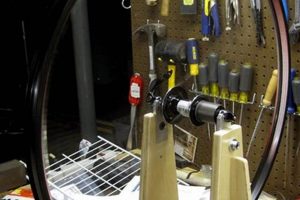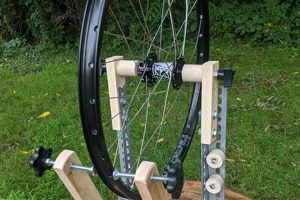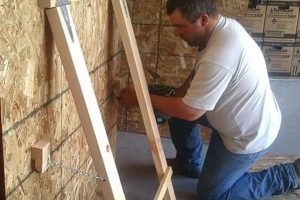A structure designed for supporting metal targets, often constructed by individuals rather than purchased pre-made, enables controlled shooting practice. These frameworks vary widely in design, employing materials such as wood, steel, or repurposed components. An example would be a welded A-frame made from steel tubing with hooks for hanging steel plates.
The value of self-constructed target supports lies in their customizability and potential cost savings. These projects permit tailoring the stand to specific target sizes, shooting distances, and terrain conditions. Historically, building these structures has offered an accessible entry point to shooting sports, allowing enthusiasts to participate without significant financial investment. The ability to repair and modify a self-made stand extends its lifespan and usefulness.
Understanding the materials, construction techniques, and safety considerations is paramount for any fabrication of this type. Subsequent sections will elaborate on design choices, material selection, and best practices for ensuring a safe and durable final product.
Construction Advice for Metal Target Supports
The following advice is crucial when fabricating metal target supports, ensuring safety and longevity.
Tip 1: Material Selection: Prioritize steel thickness appropriate for the intended caliber. Thinner gauges risk deformation or penetration, reducing the lifespan and increasing safety risks. For rifle targets, consider at least 3/8″ AR500 steel.
Tip 2: Welding Integrity: Ensure all welds are complete and possess adequate penetration. Incomplete welds represent structural weak points that can fail under stress, potentially causing targets to fall or fragments to eject unpredictably. Employ appropriate welding techniques for the steel type.
Tip 3: Stand Stability: Design the base for stability in various terrain conditions. A wider base increases resistance to tipping. Consider incorporating ground anchors or stakes for enhanced stability on uneven surfaces.
Tip 4: Target Mounting: Employ a secure target mounting system that allows for controlled swinging upon impact. Chains or rubber straps are commonly used to achieve this. Avoid rigid mounting that can transmit excessive force to the stand structure.
Tip 5: Angle of Deflection: Design the target to deflect bullet fragments downward into the ground. An angled target face directs splatter safely. Consider a forward lean of 15-20 degrees.
Tip 6: Regular Inspection: Conduct routine inspections of the stand for signs of damage or wear. Cracks in welds, deformation of steel members, or wear on mounting hardware require immediate attention and repair or replacement.
Tip 7: Transportation Considerations: Design the stand for ease of transport and storage. Modular designs or folding mechanisms simplify movement and storage, reducing the risk of damage during transport.
Implementing these tips increases the safety, durability, and functionality of self-fabricated metal target support systems.
The subsequent section provides a summary of key points and final recommendations.
1. Welding technique
The integrity of a do-it-yourself steel target stand hinges substantially on the employed welding technique. Welding serves as the primary method for joining the steel components that constitute the frame. Deficiencies in the welding process directly compromise the structural integrity of the entire stand. Incomplete welds, insufficient penetration, or the use of inappropriate welding processes for the steel type can create weak points prone to failure under stress. For instance, a target stand constructed with inadequate welds may collapse upon repeated impact from projectiles, posing a safety hazard to shooters and bystanders. Proper welding, conversely, distributes the forces evenly across the joints, maximizing the stand’s ability to withstand repeated impacts and environmental stressors.
Selecting the appropriate welding process and filler metal is paramount. Shielded Metal Arc Welding (SMAW), Gas Metal Arc Welding (GMAW), and Gas Tungsten Arc Welding (GTAW) are common choices, each possessing distinct advantages and disadvantages relative to cost, skill requirements, and weld quality. GMAW, for example, often provides a good balance of speed and weld quality for general fabrication, while GTAW offers greater precision and control, particularly advantageous for thinner materials or complex joints. The choice of filler metal must be compatible with the base metal to ensure a strong and durable weld. Moreover, proper joint preparation, including cleaning and beveling edges, significantly enhances weld penetration and reduces the risk of porosity or slag inclusions.
Ultimately, the welding technique is an indispensable element in creating a safe and durable steel target stand. Novice welders should seek guidance from experienced professionals or participate in welding training programs to acquire the necessary skills and knowledge. Regular inspection of welds for cracks, porosity, or other defects is essential to maintaining the structural integrity of the stand and preventing potential accidents. A strong, well-executed welding job is a cornerstone of a robust and reliable DIY steel target stand.
2. Material Strength
Material strength is a primary determinant of a self-constructed steel target stand’s durability and safety. The steel’s capacity to withstand repeated impacts from projectiles directly affects the stand’s lifespan. Selecting inadequate steel grades or thicknesses invariably leads to premature failure, creating hazardous conditions. A steel stand designed for pistol use, but constructed from mild steel rather than hardened AR500 steel, will exhibit deformation upon rifle bullet impact. This deformation can cause unpredictable ricochets and compromise the stand’s structural stability. Consequently, the choice of material is not merely a cost consideration but a critical safety factor.
The selection process necessitates considering the types of firearms that will be used. Different calibers and bullet velocities impart varying levels of kinetic energy upon impact. High-powered rifles necessitate the use of abrasion-resistant steel, specifically AR500 or AR550, in thicknesses of 3/8 inch or greater, to prevent penetration or significant deformation. Conversely, stands intended solely for low-caliber pistols may employ thinner gauges of mild steel, though hardened steel is recommended even for lower-powered firearms. An instance where a stand collapses due to using mild steel with a rifle highlights the importance of a proper selection.
In conclusion, material strength forms a cornerstone of safe and effective steel target stand construction. A thorough understanding of the material properties, coupled with an awareness of the anticipated ballistic forces, is essential. Failure to prioritize material strength jeopardizes the longevity of the stand, and more importantly, poses a substantial safety risk to the user and any bystanders.
3. Structural stability
Structural stability is a core attribute of any self-constructed steel target stand. It denotes the capacity of the stand to maintain its intended configuration under both static and dynamic loads. Lack of structural stability directly translates to an increased risk of the stand toppling, shifting, or collapsing during use. This instability not only disrupts the shooting experience but, more critically, introduces a serious safety hazard. A stand that unexpectedly falls presents a risk of projectile ricochet in unpredictable directions or even physical injury to individuals in the vicinity. Therefore, ensuring structural stability is of paramount importance in the planning and execution of any self-constructed steel target support.
Several factors contribute to the overall structural stability of a DIY stand. Base design is crucial; a wider base provides a lower center of gravity, enhancing resistance to tipping. The material used also plays a significant role; heavier gauge steel offers greater inherent stability compared to thinner, lighter materials. The method of joining components, typically welding, directly affects the stand’s ability to withstand stress. Poorly executed welds represent weak points that can compromise the entire structure. Moreover, the presence of external forces such as wind or uneven terrain necessitate design considerations to mitigate potential instability. A practical example of this is ensuring adequate leg bracing on a stand designed for outdoor use, reinforcing the structure against wind loads. Another example is using a wider and heavier base when placing the stand on soft soil.
In summation, structural stability is not merely an aesthetic consideration but a functional imperative for a steel target stand. A stand lacking adequate stability introduces unnecessary risks and detracts from the overall safety and utility. The importance of structural stability can not be overstated, and must be at the forefront of the mind during planning, and execution. Every stage of fabrication should include continuous review of structural stablity. Rigorous testing and evaluation of the finished stand are essential to verify its stability before use, mitigating potential hazards and assuring a safe and enjoyable shooting experience.
4. Target angle
The angle at which a steel target is oriented on a self-constructed stand fundamentally influences the trajectory of bullet fragments upon impact. A vertically positioned target directs fragments in multiple directions, creating a hazard zone around the stand. Conversely, angling the target downward deflects the majority of fragments into the ground directly in front of the stand. This directional control is a critical safety measure, minimizing the risk of ricochets striking the shooter or bystanders. An illustrative example involves comparing two setups: one with a vertical target resulting in fragment spread, and another with a 15-degree downward-angled target confining fragments to a small ground area. This clearly highlights the safety improvements offered by proper angulation.
Achieving the correct angle in target stand fabrication requires careful design and precise execution. The stand must be constructed to maintain the desired angle consistently, preventing unintentional changes during use. Incorporating a fixed angle into the stand’s design, through welding or bolted connections, helps ensure stability. Adjustable angles, while offering flexibility, introduce potential points of failure if not properly secured. Moreover, the target mounting method must facilitate the intended angle. For example, mounting a steel plate with chains allows for swing but needs to be combined with a stand design that guarantees the correct initial angle.
In summary, target angle is an indispensable safety feature of a steel target stand. Proper angulation mitigates the hazards associated with bullet fragment ricochet. Challenges in achieving and maintaining the correct angle underscore the need for careful planning and precise construction. Implementing this knowledge into the structure of a DIY steel target stand guarantees enhanced safety, and a better shooting experience.
5. Portability solution
The ability to transport a self-constructed steel target stand, referred to as a portability solution, directly influences its practical utility. This attribute enables shooters to utilize their stands at various locations, including designated shooting ranges and private properties, thereby expanding training opportunities. The ease with which a stand can be moved impacts its frequency of use.
- Collapsible Design
A collapsible framework facilitates transportation by reducing the overall volume of the stand when disassembled. Hinged joints or quick-release fasteners allow for rapid breakdown and reassembly. An example would be a stand using hinged legs that fold flat against the central support structure. This approach allows storage in vehicles with limited cargo space.
- Modular Construction
Modular designs consist of separate, interlocking components that can be transported individually. This method distributes the weight of the stand, making it easier to manage, particularly when dealing with heavy-gauge steel. A modular stand might consist of a base, upright supports, and target mounting brackets, each carried separately.
- Integrated Handles
The incorporation of handles onto the stand’s frame provides convenient grip points for lifting and carrying. Strategically placed handles can improve weight distribution and reduce strain during transport. An example involves welding handles onto the sides of the base frame, allowing for two-person carrying of heavier stands.
- Wheeled Systems
Attaching wheels to the base of the stand allows for easy rolling across various surfaces. This approach minimizes the need for lifting, particularly beneficial for heavier stands or uneven terrain. A wheeled system might consist of two fixed wheels and a retractable handle, enabling users to move the stand like a wheelbarrow.
These portability strategies enhance the practicality of a do-it-yourself steel target stand. The choice of solution depends on factors such as stand weight, size, and the typical transport environment. Combining multiple strategies, such as a collapsible design with integrated handles, can further optimize portability.
Frequently Asked Questions
The following questions address common concerns regarding the design, construction, and safe operation of self-constructed steel target stands. These answers aim to provide clarity and guidance for individuals undertaking such projects.
Question 1: What is the minimum safe distance to use a steel target stand?
The minimum safe distance varies with the firearm caliber. Rifle calibers typically require greater distances than pistol calibers due to increased projectile velocity and potential for fragmentation. Consult established range safety protocols and manufacturer recommendations for specific distances applicable to the firearm and ammunition being used.
Question 2: What type of steel is best for a target stand intended for rifle use?
Abrasion-resistant steel, specifically AR500 or AR550, is the recommended material. These steels are hardened to withstand repeated impacts from rifle bullets without significant deformation or penetration. A minimum thickness of 3/8 inch is generally advised.
Question 3: How should steel targets be mounted to the stand to ensure safety?
Targets should be mounted using chains or rubber straps that allow the target to swing freely upon impact. This swinging action dissipates energy and reduces the risk of projectile ricochet. Avoid rigid mounting methods, which can increase the likelihood of unpredictable fragment trajectories.
Question 4: What is the recommended angle for a steel target to deflect bullet fragments safely?
A downward angle of 15 to 20 degrees is generally recommended. This directs the majority of bullet fragments into the ground in front of the stand, reducing the risk of ricochet. The angle must be consistent to maintain its safety effectiveness.
Question 5: How frequently should a DIY steel target stand be inspected for damage?
A thorough inspection should be conducted before each use. Examine welds for cracks, steel members for deformation, and mounting hardware for wear or damage. Any sign of compromise necessitates immediate repair or replacement of the affected component.
Question 6: Is it acceptable to use self-fabricated steel target stands at commercial shooting ranges?
Many commercial shooting ranges have specific regulations regarding target stand construction. It is crucial to verify that the self-fabricated stand meets all range requirements before use. Some ranges may prohibit the use of homemade stands altogether due to liability concerns.
Prioritizing safety is of utmost importance when building and using any target stand, regardless of experience or skill level. Ensuring the selection of proper materials and following guidelines for proper construction, regular inspection, and distance should allow for a more safe practice.
The subsequent section offers an expanded conclusion on DIY steel target stands.
Conclusion
The preceding discussion has examined crucial factors relevant to the design and fabrication of a DIY steel target stand. Considerations such as material selection, welding technique, structural stability, target angle, and portability solution significantly influence the functionality and safety of the finished product. Ignoring these aspects can result in compromised performance and elevated risk of injury.
Responsible construction and utilization of a DIY steel target stand necessitate adherence to established safety protocols, diligent inspection practices, and a thorough understanding of ballistic principles. Any deviation from recommended guidelines can have serious consequences. Diligence in these areas promotes both a safer and more effective shooting experience.







